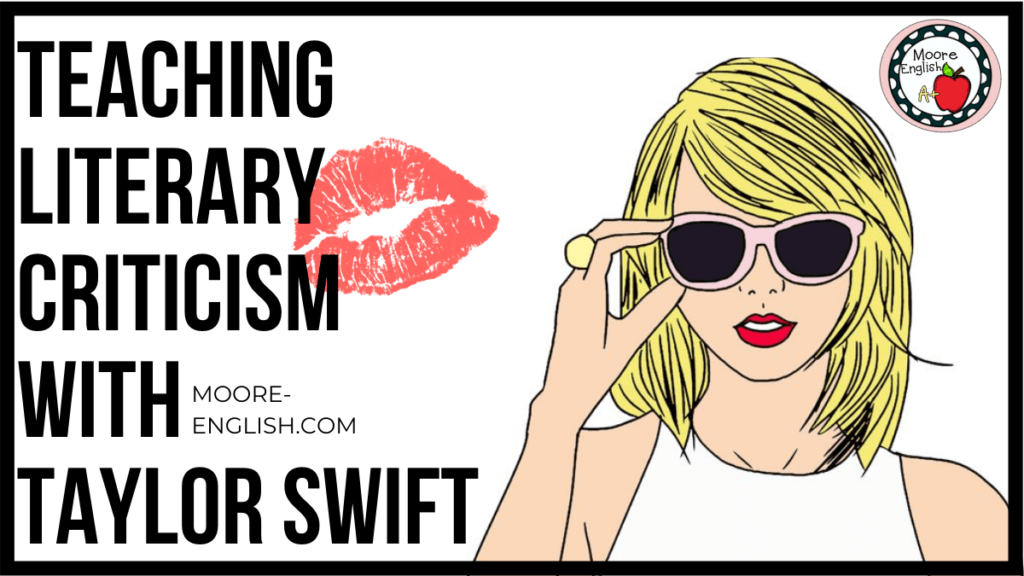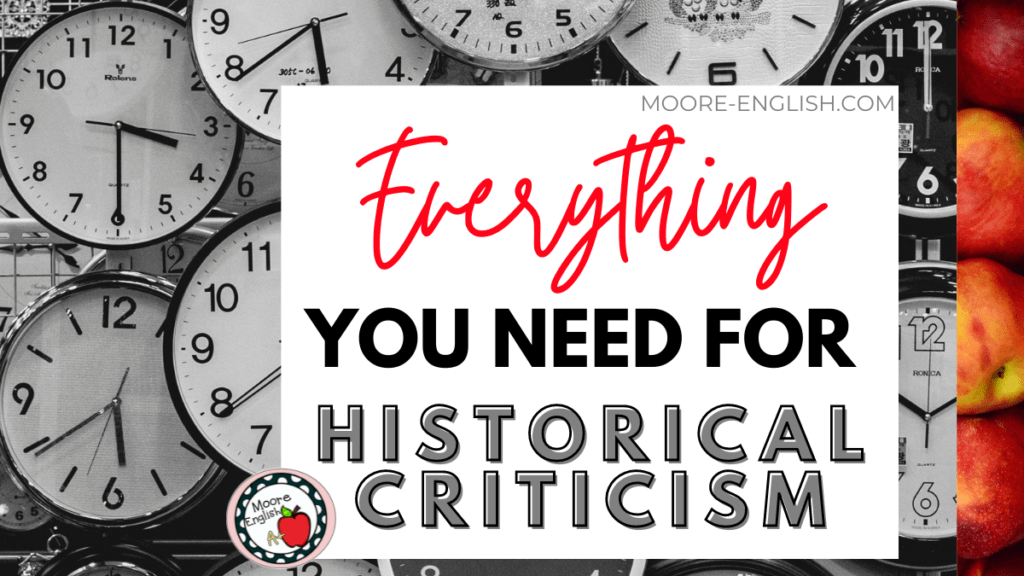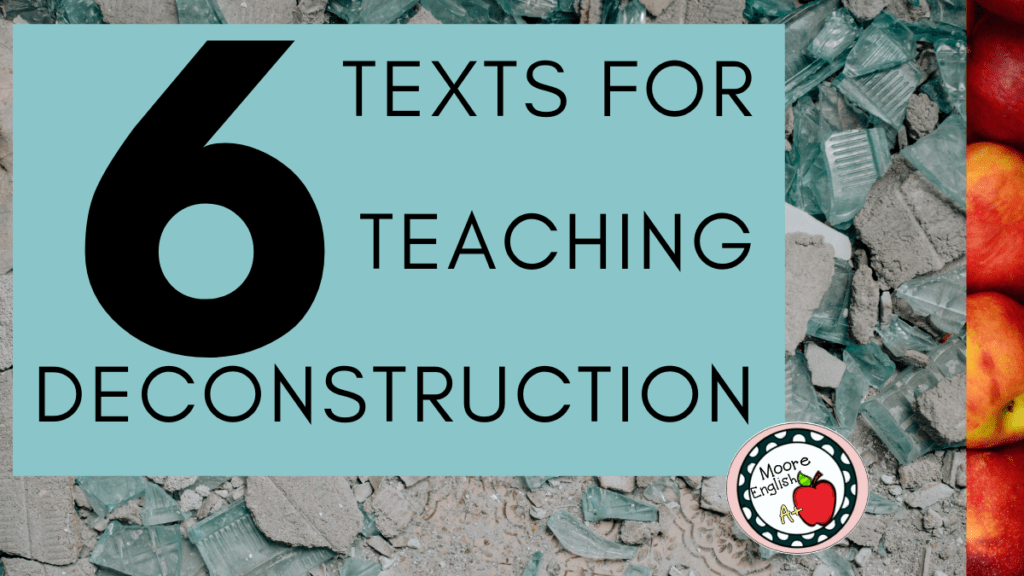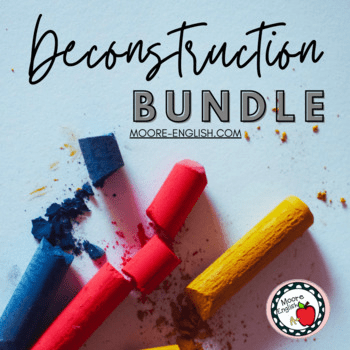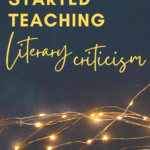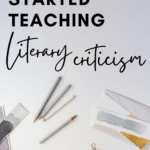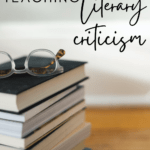While I love to teach literary criticism, it’s not everyone’s cup of tea. For this reason, I wanted to put together a “starter pack” to help everyone teach literary criticism. As a student, I didn’t learn about literary criticism until college, but there are plenty of reasons to consider introducing lit crit in high school:
- First, literary criticism requires creative and innovative thinking, so students feel challenged and engaged.
- Second, literary criticism encourages empathy and perspective-taking (two of Wiggins and McTighe’s facets of understanding).
- Additionally, literary criticism can be framed to invite research and synthesis-thinking, two skills invaluable beyond the classroom.
This post this post may contain affiliate links. Please read the Terms of Use.
Introducing Literary Criticism
I never did literary criticism in high school. And Thursday when I was thinking about texts I wish I’d read in high school, I realized literary criticism was also missing from my high school education. While literary criticism may seem like an abstract concept for high school students, here are 5 reasons to include literary criticism in your high school literature classes. 5 Reasons to Teach Literary Criticism 1. Improve critical thinking. First, applying a critical lens to a text requires students to make inferences, analyze text, and synthesize the text with the critical lens. Further, all of these skills
Teaching Literary Criticism with Taylor Swift
Literary criticism is challenging for students. But using familiar lyrics from Taylor Swift can help demystify complex literary lenses!
10 Texts to Introduce Archetypal Criticism in High School ELA
Oftentimes, textbooks about literary criticism group mythological and archetypal criticism. For more advanced students, this grouping makes perfect sense. However, at the high school level, grouping these two critical lenses together can often create a greater sense of confusion for students. For this reason, I have learned to approach mythological and archetypal criticism as two seperate lenses. Today, I want to share some of my favorite texts for teaching archetypal criticism. Introducing Archetypal Criticism Even if literary criticism isn’t new for students, the term “archetype” is daunting! To help students unpack this term, I often use this set of free
How to Introduce Historical Criticism in Language Arts Class
At my school, our American literature class is mostly chronological. Students move from early American writing to the contemporary period. In the course, students have the opportunity to analyze the development of American literature. By the end of the course, students are able to explain the forces that led American literature to its current state. As a result, we spend a lot of time discussing literary movements and their historical and cultural context(s). By the end of the year, students are well-versed in historical criticism. With this in mind, I wanted to share some strategies, resources, and text suggestions for
6 Texts for Introducing Biographical Criticism
When introducing literary criticism, biographical criticism is often where I begin. Over the years, students have often engaged in biographical criticism without knowing its name. For example, this year, one of my students read the graphic novel Dragon Hoops, which draws heavily on its author’s life experiences. During his Book Cover Design presentation, the student shared information about how the author’s life relates to the book. To guide students through biographical criticism, we often focus on these questions: How does the author’s life relate to the story? Are the characters similar to or different from the author? Which of the
23 Texts to Introduce Feminist Criticism in High School ELA
When I introduce literary criticism to my students, feminist criticism is one of the first lenses we use. In part, we encounter feminist criticism early on because students know the word “feminist” or “feminism” without always know what those terms mean. Unfortunately, some of my students often have negative attitudes toward “feminist” and “feminism.” Introducing feminist criticism helps students unpack those terms and better understand what it means to be a feminist. Additionally, at the high school level, feminist criticism is fairly straightforward. When applying feminist criticism, we are basically looking at how a text treats its womxn characters. In
13 Texts for Introducing Psychoanalytical Criticism in High School ELA
Psychoanalytical criticism is a complex critical lens. The different levels of psychoanalytical criticism make it challenging for students and, sometimes, uncomfortable for teachers. For these reasons, when I introduce psychoanalytical criticism to my juniors, I try to keep it simple. Here’s what we focus on: a brief introduction to Freud quick notes about the ego, ID, and Superego an acknowledgement that there is more to psychoanalytical criticism but that we are using the “starter pack” and, perhaps most importantly, that applying psychoanalytical criticism does not make us mental health experts, so we are not going to diagnose characters (or each
12 Texts for Introducing Marxist Criticism
When my students study literary criticism, I usually introduce Marxist criticism after feminist criticism. In part, I introduce these two lenses in close order because they are both political lenses. They’re not political in the sense of partisan politics. But they both deal with how literature navigates issues of power and privilege. However, I usually introduce Marxist criticism after feminist criticism because students stumble over the “Marxist” title. Students know Karl Marx from their social studies classes. And they know about communism from reading The Crucible. Sometimes that leads students to believe that Marxist criticism is all about communism. So
40 Texts for Teaching Literary Criticism
This week, my juniors will make their first foray into literary criticism. In the past, I’ve written about the importance of incorporating literary criticism in secondary English. Today, I’ll share texts that are perfect for introducing literary criticism. As you choose texts for introducing literary criticism, remember that the goal of the lesson. While you want to choose an appropriate text, you also want to choose an approachable text. And literary crit is intimidating enough without choosing a text that is too dense. Formalist Criticism To begin, formalist or New Criticism is all about the unified whole. So look for a
How to Introduce Deconstruction in High School ELA
Literary criticism is one of my favorite ways to approach a text. Once I’ve introduced literary criticism and students have grappled with the basics, they really start to engage in creative thinking. I am constantly blown away with students’ abilities to see texts in new, innovative ways. When I am fortunate to have a group of students that really takes to literary criticism, I challenge them by introducing deconstruction. To be clear, this is not a critical lens that I always teach. Instead, this is the *bonus* lens I use for students that are really rocking with literary criticism. Where
Favorites to Teach Literary Criticism
Over the years, I’ve tried countless ways to teach literary criticism. Since I’ve tried so may different strategies, I wanted to share some of my favorite lessons and strategies.
- First, carefully consider which critical lenses you will teach and in which order. Rarely do you need to cover every lens. For example, I’m always particular about deconstruction. It’s such a complex perspective that I often omit this lens.
- Second, choose texts that lend themselves to several lenses. This will get you the most “bang for your buck,” so more time can be spent engaged with a critical lens and less time is spent on reading. For example, “A Worn Path” by Eudora Welty and “A White Heron” by Sarah Orne Jewett are two of my favorite texts to begin with. Each text lends itself to multiple interpretations.
- Additionally, as you choose texts, focus on texts that are easier to understand. For this reason, teachers might even consider choosing low-stress texts like songs, television episodes, and/or comics. Since these are not intimidating texts, students can spend more time in analysis and less time stressing about comprehension.
- Finally, take some interpretative risks. Try different lens-text combinations. Literary criticism is surprising and sometimes shocking, so don’t be afraid to play with different combinations and passages! Students will respond to your enthusiasm!
Resources for Teaching Literary Criticism




